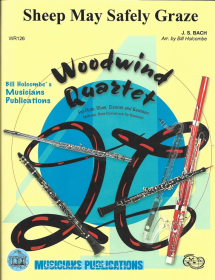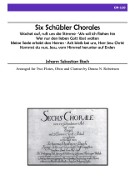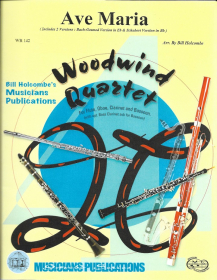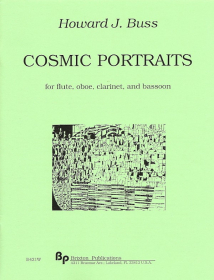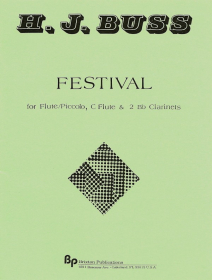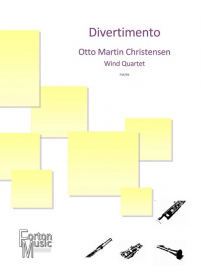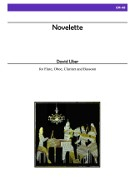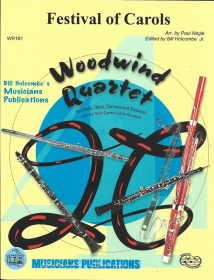Woodwind Quartet
-
Albeniz, I :: Capricho Catalan & Zortzico
Capricho Catalan & Zortzico
Albeniz, I
Musicians Publications presents Isaac Albeniz s Capricho Catalan & Zortzico from Espana arranged for woodwind quartet by Bill Holcombe and Bill Holcombe Jr. Scored for flute, oboe, clarinet, and bassoon, this quartet also includes a bass clarinet part to substitute for the bassoon when necessary. This arrangement is advanced in difficulty and 3:15 in duration.
Isaac Albeniz was born in May 1860 in Catalonia, Spain. Albeniz achieved fame as a pianist and composer. A child prodigy, he made his debut at the age of 4 and his performance was so astonishing that some considered the possibility of fraud. At the age of 7 he gave concerts in Paris and at the same age wrote a Pasadoble that was played by military bands in Barcelona. A student of composition in various conservatories throughout Europe, his ambition was to study with Franz Liszt and he achieved that goal at the tender age of 18.
Concert tours around the world and in the USA ensued and he settled permanently in Paris and became great friends with Claude Debussy. The body of works created by Albania includes three operas, and many pianoforte classics, among them his masterwork Iberia & Espana (one of his more notable pieces composed in 1890 contains the celebrated Tango , which is known as one of his most popular works). Espana is more delightful and accessible (much easier) than Iberia . It is made up of six piano pieces that subtly reflect the influences of the piano literature of the 19th century salon, and like Iberia , the harmony and style of impressionism which Albeniz himself helped to create. Both works reveal characteristics of the highly individualized piano technique Albeniz developed from early childhood and perfected under the tutelage of Liszt. - Bill Holcombe
-
Albeniz, I :: Malaguena & Serenata
Malaguena & Serenata
Albeniz, I
Musicians Publications presents Isaac Albeniz s Malaguena & Serenata from Espana arranged for woodwind quartet by Bill Holcombe and Bill Holcombe Jr. Scored for flute, oboe, clarinet, and bassoon, this quartet is advanced in difficulty and 3:15 in duration.
Isaac Albeniz was born in May 1860 in Catalonia, Spain. Albeniz achieved fame as a pianist and composer. A child prodigy, he made his debut at the age of 4 and his performance was so astonishing that some considered the possibility of fraud. At the age of 7 he gave concerts in Paris and at the same age wrote a Pasadoble that was played by military bands in Barcelona. A student of composition in various conservatories throughout Europe, his ambition was to study with Franz Liszt and he achieved that goal at the tender age of 18.
Concert tours around the world and in the USA ensued and he settled permanently in Paris and became great friends with Claude Debussy. The body of works created by Albania includes three operas, and many pianoforte classics, among them his masterwork Iberia & Espana (one of his more notable pieces composed in 1890 contains the celebrated Tango , which is known as one of his most popular works). Espana is more delightful and accessible (much easier) than Iberia . It is made up of six piano pieces that subtly reflect the influences of the piano literature of the 19th century salon, and like Iberia , the harmony and style of impressionism which Albeniz himself helped to create. Both works reveal characteristics of the highly individualized piano technique Albeniz developed from early childhood and perfected under the tutelage of Liszt. - Bill Holcombe
-
Albeniz, I :: Preludio & Tango
Preludio & Tango
Albeniz, I
Musicians Publications presents Isaac Albeniz's Preludio & Tango from Espana arranged for woodwind quartet by Bill Holcombe and Bill Holcombe Jr. Scored for flute, oboe, clarinet, and bassoon, this quartet also includes a bass clarinet part to substitute for the bassoon when desired. It is advanced in difficulty and 2:15 in duration.
Isaac Albeniz was born in May 1860 in Catalonia, Spain. Albeniz achieved fame as a pianist and composer. A child prodigy, he made his debut at the age of 4 and his performance was so astonishing that some considered the possibility of fraud. At the age of 7 he gave concerts in Paris and at that same age wrote a Pasadoble that was played by military bands in Barcelona. A student of composition in various conservatories throughout Europe, his ambition was to study with Franz Liszt and he achieved that goal at the tender age of 18.
Concert tours around the world and in the USA ensued and he settled permanently in Paris and became great friends with Claude Debussy. The body of works created by Albania includes three operas, and many pianoforte classics, among them his masterwork Iberia & Espana (one of his more notable pieces composed in 1890 and contains the celebrated Tango , which is known as one of his most popular works). Espana is more delightful and accessible (much easier) than Iberia . It is made up of six piano pieces that subtly reflect the influences of the piano literature of the 19th century salon, and, like Iberia , the harmony and style of Impressionism, which Albeniz himself helped to create. Both works reveal characteristics of the highly individualized piano technique Albeniz developed from early childhood and perfected under the tutelage of Liszt.
-
Albeniz, I :: Three Pieces from Espana
Three Pieces from Espana
Albeniz, I
Three Pieces from Espana arranged for flute, oboe, clarinet and bassoon.
-
Bach, JS :: Air For The G String
Air For The G String
Bach, JSMusicians Publications presents J.S. Bach s Air For The G String arranged for woodwind quartet by Bill Holcombe and Bill Holcombe Jr. Scored for flute, oboe, clarinet, and bassoon, this arrangement is intermediate in difficulty and 3:35 in duration. What s interesting about this edition, is that it contains two versions of the work: one in the original key of D major and another in F major.
Air is a piece from Bach s Third Orchestral Suite in D Major, BWV 1068. The Third Suite may be the most famous of the four on account of its meltingly beautiful Air. One of the most popular and arranged pieces of all time, it achieved special notoriety through August Wilhelmj s version for the violin G string (1871). The Air s binary form two halves, each repeated and its stepping bass overlaid with a long, sustained melodic line are standard Baroque procedures, but its poignant effect transcends all formulas. - Jane Vial Jaffe
-
Bach, JS :: Aria 'Sheep May Safely Graze'
Aria 'Sheep May Safely Graze'
Bach, JS
Sheep May Safely Graze for Two Flutes, Oboe and Bassoon
-
Bach, JS :: Bach 3-Part Inventions, Vol III
Bach 3-Part Inventions, Vol III
Bach, JSMusicians Publications presents Johann Sebastian Bach's 'Three-Part Inventions, Volume 3' which includes Inventions 11-15 arranged for woodwind quartet by Jerry Nowak. Scored for flute, oboe, clarinet, and bassoon, this arrangement also includes an optional bass clarinet part to substitute for the bassoon, and an optional clarinet part to replace the oboe when desired.
The fifteen Bach 'Three-Part Inventions' (ideas) were originally entitled 'Sinfonias' and written for the piano. The source for these versions for woodwind quartet was the urtext published by C.F. Peters. In his commentary, Bach hoped that the study of these pieces would help players achieve a 'cantabile' style of playing and a better understanding of music composition. The original version had no tempo or style indications and no dynamics or articulations. Other published versions contain tempo markings, style indications, dynamics, slurs, and articulations that were added later by Bach's family members, his students, or editors. Invention Number Five is as Bach wrote it without numerous decorations which were added later. Invention Number 15 has been set in nine-eight rather than the original meter of nine-sixteen.
-
Bach, JS :: Sheep May Safely Graze
Sheep May Safely Graze
Bach, JSMusicians Publications presents J.S. Bach's Sheep May Safely Graze arranged for flexible woodwind quartet by Bill Holcombe. Scored for flute, oboe, clarinet, and bassoon, this flexible quartet also includes an optional bass clarinet part to replace the bassoon when necessary. This arrangement is intermediate-advanced in difficulty.
In addition to his 199 surviving sacred cantatas, Bach composed several secular cantatas for various occasions. Cantata 208, the Hunting Cantata, more popularly known today by the title Sheep May Safely Graze , was written in 1716 for the thirty-first birthday of Duke Christian of Sachsen-Weissenfels and was performed as banquet music in his hunting lodge after a hunt. This well-known soprano aria is preceded by a recitative whose text is as follows:
Shall Pales be the last thus her respects to pay? No! I would raise my voice in song, so as the woods and land with vivats ring, here in this lovely field in honor of our Prince, I sing a joyous song of praise!
The aria text is: Flocks and herds may safely pasture when their shepherd guards them well. They whose monarch loves them truly knows their needs and fills them duly, will in peace and concord dwell.
- Baylor University Symphonic Band, 2017
-
Bach, JS :: Six Schubler Chorals
Six Schubler Chorals
Bach, JS
Chorales is a name usually given to the Sechs Chorale von verschiedener Art ('Six Chorales of Various Kinds') for organ, issued around 1748. The title 'Schubler Chorales' derives from the engraver and publisher Johann Georg Schubler, who is named on the original title page. These six chorales have been arranged for woodwind ensemble by Donna N. Robertson. Four of the chorales can be played by a trio (Flute, Oboe, Clarinet), and the remaining two require an additional Flute.
Full instrumentation: 2 Flutes (Flute 2 is tacet for chorales 1, 2, 5, 6), Oboe, Clarinet.
-
Bach, JS :: Sleepers, Wake: Arie 6
Sleepers, Wake: Arie 6
Bach, JSMusicians Publications presents J.S. Bach's Sleepers, Wake: Arie 6 arranged for flexible woodwind quartet by Carson Rothrock. Scored for flute, oboe, clarinet, and bassoon, this flexible quartet also includes an optional bass clarinet part to replace the bassoon when necessary. This arrangement is intermediate-advanced in difficulty.
Program notes by the arranger: The 'Arie' I have arranged for woodwind quartet is from the famous cantata by J.S. Bach known as Sleepers, Wake! It is the sixth section of Cantata No. 104. Sleepers, Wake is a good translation of the title ( Wachet Auf, Uns Ruft Die Stimme). Literally translated it means: wake up, the voice is calling us.
I have used a source that is said to be based on the Bach-Gesellshaft edition. There are no tempo markings and few articulations. The Arie is the sixth movement of the cantata. The third movement is also an Arie and also a duet for soprano and bass. The obligato of No. 6 is divided between oboe and violin.
The beginning, middle, and ending movements are chorales, settings of Phillip Nicolai s famous hymn. His words refer to the gospel of the day likening Christ to a bridegroom. The watchman exhorts the city of Jerusalem to prepare because the voice is calling at midnight. The chorale (movement 4) exhorts all to follow Jesus, God's son, to the place of the evening meal.
The Arie No. 6 could have been used at weddings because of the words promising faithfulness to God on the part of the groom and faithfulness to the husband on the part of the bride. - Carson Rothrock, 2007
-
Bach, JS; Gounod, C :: Ave Maria
Ave Maria
Bach, JS; Gounod, CMusicians Publications presents Ave Maria arranged for woodwind quartet by Bill Holcombe. Scored for flute, oboe, clarinet, and bassoon, this flexible quartet also includes an optional bass clarinet part to replace the bassoon when necessary. This arrangement is intermediate-advanced in difficulty. It includes 2 versions; one originally composed by Bach-Gounod in E-flat major and one originally composed by Franz Schubert in B-flat.
French composer Charles Gounod, is probably best known for creating a melody that eventually was to become an Ave Maria that was to be sung over Johann Sebastian Bach s 'C Major Prelude from the Well-Tempered Klavier . Fanny Mendelssohn who was the sister of the famous composer, conductor and music historian (particularly on Bach) Felix, introduced the music of Bach to Gounod, who quickly became enamored with the old music. - Jay Fishman
Schubert wrote this piece in the spring summer of 1825, with words taken from one of the poems in the epic, The Lady on the Lake by Walter Scott (1771-1832). Schubert set seven poems in this epic to music and Ave Maria was the 6th. It is a prayer of a maiden named Ellen asking for forgiveness of her father of her father s sin as she kneels down before an image of the Virgin Mary set up on the rocky hill by the lake. The German translation of the poem was made by Adam Storg. The song is written in the strophelied form consisting of three sections, with the tempo designated as lento . The quiet and pious melody in slow tempo is rendered with a piano accompaniment imitating a harp. The song moved the hearts of many people when it first appeared and Schubert loved to sing it. Today it is a world wide favorite thanks to a German violinist, AF.V. Wilhelmi (1845-1908) who arranged it as Violin Solo in C major. - The New York Symphonic Ensemble, 1991
-
Berlin, I :: Alexander's Ragtime Band
Alexander's Ragtime Band
Berlin, IMusicians Publications presents Irving Berlin s Alexander s Ragtime Band arranged for woodwind quartet by Bill Holcombe Jr. Scored for flute, oboe, clarinet, and bassoon, this quartet is intermediate-advanced in difficulty.
One of the most popular and influential pieces of the early twentieth century, Alexander s Ragtime Band paved the way for the beginnings of the famous Tin Pan Alley. Berlin was primarily a popular songwriter and whatever was selling was the style of his next composition. Alexander was the name used when people of authority would call a Negro bandleader, thus the name of the song as typical of the Negro jazz band. It is played in the original arrangement published in 1911. - Dr. Karl Koenig
-
Bizet, G :: Carmen Suite
Carmen Suite
Bizet, GMusicians Publications presents Georges Bizet s Carmen Suite arranged for woodwind quartet by Bill Holcombe and Bill Holcombe Jr. Scored for flute, oboe, clarinet, and bassoon, this suite of works from the opera Carmen includes Prelude , Habanera , and Carmen Fantasia .
Georges Bizet composed several operas, including The Pearl Fishers , before Carmen , but the latter is universally considered his masterpiece and still one of the most popular operas on today s stages. Sadly, Bizet did not live to see his story of the fatal love between a gypsy woman and a renegade soldier become a worldwide success: the premiere at the Opera-Comique, just weeks before his untimely death, met with little enthusiasm from either public or critics. The story was considered too sordid for a family opera house, and the music so familiar today even to those who never attend opera baffled audiences: one critic called it dull and obscure ; others, incredibly, found it tuneless and steeped in Wagnerism, meaning the orchestra was too dominant. - Sheboygan Symphony Orchestra, 2014
-
Bozza, E :: Trois Pieces [Three Pieces]
Trois Pieces [Three Pieces]
Bozza, E
Trois Pieces pour une musique de nuit includes score and parts. -
Buss, HJ :: Cosmic Portraits
Cosmic Portraits
Buss, HJHoward J. Buss presents Cosmic Portraits for flute, clarinet, alto sax, and tenor sax.
Cosmic Portraits consists of 3 movements inspired by views of objects in the Milky Way galaxy. The titles of the first 2 movements, The Backbone of Night and The Pale Blue Dot are taken from the writings of the renowned astrophysicist, Carl Sagan. In his book, Cosmos, he describes how the !Kung Bushman in Botswana refer to the Milky Way as 'the backbone of night.' The spine of the Milky Way often appears directly over the Kalahari Desert. The !Kung believe it to be the structural foundation of the heavens and that one of its functions in relation to Earth, among many, is that it holds up the darkness. In his book, The Pale Blue Dot, Sagan poetically describes a haunting view of Earth from a distant point in our galaxy. He puts our worldly concerns into cosmic perspective when he refers to all that has ever happened to human beings as occurring 'on a mote of dust suspended in a sunbeam.'
The final movement, Orbitals, suggests celestial bodies revolving around one another in a fascinating cosmic dance. Moons orbiting planets, planets around suns, suns around other suns culminate in the swirling wonder of our galaxy.
-
Buss, HJ :: Cosmic Portraits
Cosmic Portraits
Buss, HJHoward J. Buss presents Cosmic Portraits for flute, oboe, clarinet, and bassoon.
Cosmic Portraits consists of 3 movements inspired by views of objects in the Milky Way galaxy. The titles of the first 2 movements, The Backbone of Night and The Pale Blue Dot are taken from the writings of the renowned astrophysicist, Carl Sagan. In his book, Cosmos, he describes how the !Kung Bushman in Botswana refer to the Milky Way as 'the backbone of night.' The spine of the Milky Way often appears directly over the Kalahari Desert. The !Kung believe it to be the structural foundation of the heavens and that one of its functions in relation to Earth, among many, is that it holds up the darkness. In his book, The Pale Blue Dot, Sagan poetically describes a haunting view of Earth from a distant point in our galaxy. He puts our worldly concerns into cosmic perspective when he refers to all that has ever happened to human beings as occurring 'on a mote of dust suspended in a sunbeam.'
The final movement, Orbitals, suggests celestial bodies revolving around one another in a fascinating cosmic dance. Moons orbiting planets, planets around suns, suns around other suns culminate in the swirling wonder of our galaxy.
-
Buss, HJ :: Dry Bones
Dry Bones
Buss, HJ
This well-known African American spiritual (the foot bone's connected to the leg bone, the leg bone's connected to the...), arranged by Howard Buss, makes a memorable concert feature as well as a rousing musical offering in church.
This arrangement, for woodwind quartet, is hugely influenced by jazz. The extended two-part introduction begins hymn-like and then breaks out in a jubilant jazzy section. This is followed by a more traditional rendering of the spiritual; however, as the music reaches its climax, the jazz 'licks' from the introduction are brought back as counterpoint against the main melody of the spiritual. The result is exhilarating, and for a bit of humor, just as the work ends, there is a 'tongue-in-cheek' plagal cadence.
-
Buss, HJ :: Festival
Festival
Buss, HJ
Howard J. Buss presents Festival for flute doubling picc, c flute, and 2 Bb clarinets.
An imaginative quartet that exudes a contagious optimism. This beautiful, compelling work showcases Buss unique style of soaring lyricism and exciting contrasts. Everyone in the ensemble has a interesting part as well. It is a memorable and upbeat concert piece and makes a joyous musical offering in church.
-
-
Christensen, OM :: Divertimento
Divertimento
Christensen, OM
In three movements, this Divertimento is entertaining and fun to play. Mixing tango-like sections, baroque style sequences and jazz harmonies with flowing melodies this is a great piece for the developing quartet.
Woodwind quartet - flute, oboe, clarinet, bassoon.









